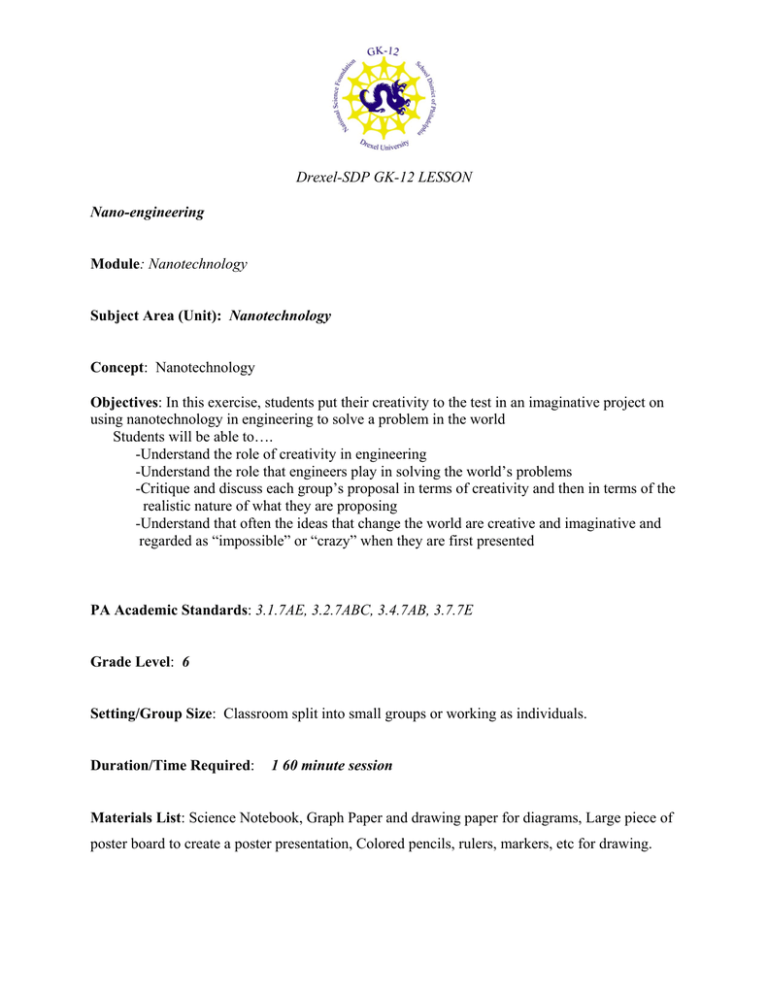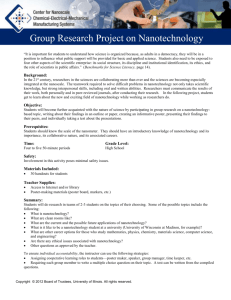using nanotechnology in engineering to solve a problem in the... Students will be able to….
advertisement

Drexel-SDP GK-12 LESSON Nano-engineering Module: Nanotechnology Subject Area (Unit): Nanotechnology Concept: Nanotechnology Objectives: In this exercise, students put their creativity to the test in an imaginative project on using nanotechnology in engineering to solve a problem in the world Students will be able to…. -Understand the role of creativity in engineering -Understand the role that engineers play in solving the world’s problems -Critique and discuss each group’s proposal in terms of creativity and then in terms of the realistic nature of what they are proposing -Understand that often the ideas that change the world are creative and imaginative and regarded as “impossible” or “crazy” when they are first presented PA Academic Standards: 3.1.7AE, 3.2.7ABC, 3.4.7AB, 3.7.7E Grade Level: 6 Setting/Group Size: Classroom split into small groups or working as individuals. Duration/Time Required: 1 60 minute session Materials List: Science Notebook, Graph Paper and drawing paper for diagrams, Large piece of poster board to create a poster presentation, Colored pencils, rulers, markers, etc for drawing. Context: After completing the first two lessons in nanotechnology, students should begin to gain some perspective on the nano-world and how things behave and react differently on the atomic scale. In conjunction with the unit on engineering, this activity can be used to strengthen the idea of creativity in engineering stressing the idea that engineers are actually artists that use the tools provided them to “paint” a solution to a problem. In this activity, the students will chose a world problem. Anything from curing cancer, to ending hunger, to waste disposal and environmental clean up could be possible topics. After choosing a topic, the students are then asked to use their knowledge of the nano-world to propose a solution that can assist in solving their particular problem using nanotechnology. No research or reading is required. Students should use their imagination, “If you could nano-engineer a machine, a chemical or anything else, how would you use that skill to solve your chosen problem”. The goal of the exercise is to create a discussion and foster imagination of what could be engineered. The exercise should both demonstrate to the students the major role that creativity plays in engineering and also in highlighting an engineer’s role in solving the world’s problems. Methods and Procedure: First begin a discussion of the major problems that exist in the world today. Hunger, pollution, disease, etc. Discuss how these problems are being solved by groups, governments and other entities, being sure to highlight each time a student mentions an “engineered” solution. At this point, a short story on how engineering has solved a major societal problem would be appropriate. Discuss how civil engineering eliminated disease spread through waste and trash in the streets. Discuss how materials and chemical engineering created artificial bones or other parts that can be implanted in the body to repair problems. Discuss how the creation of the internet allows people from anywhere in the world to gather information on topics that just a short time ago they might not have had access to. Once this initial discussion is complete, create a list of problems that the students think are important to find solutions to or to create technology to alleviate. Then ask them to pick the problem that they think is most important to create a solution to. Return to a quick reminder about the topics covered in nanotechnology and remind them that each day engineers and scientist develop ways to build and manipulate things on the nano-scale. With this in mind, ask them to come up with a proposal based on nano-technology that would solve or help alleviate the problem that they chose as the most important. First they should clearly state the problem. After that, they should outline the basics of what their nano-invention would do i.e. a robot that could maneuver through blood vessels to find and destroy viruses. Ask them to then create a detailed of what their invention would be. What materials would it be made of, how might it be manufactured, where would it get its power, how would it effect the environment, how much would it cost, etc. They should create diagrams and drawing of their invention and create a poster to explain their idea to a non-engineer. Why would someone want to support their project? Finally, ask each group to give a 5-minute presentation on their project and idea. Encourage the students watching to ask questions and engage in a discussion of both the proposed solution and what else might be done to assess the problem. Take some time to add relevant research or information concerning the technology they are presenting, has it already been done, are engineers or scientists working on it now? Is there a reason it is or is not possible? Assessment: Have the students briefly write-up a paragraph on their project in their science notebooks. What were their projects strengths, how did it compare to the presentations of other groups? Return to a discussion on the role of creativity in engineering. Note that inventions that may seem impossible today are often the technology that is used to solve problems in the future. Further note the role of an engineer in solving problems faced by the world. Presentation – Poster and Oral Science Journal Entry Keywords: Wireless Communication Author: Eric Gallo





